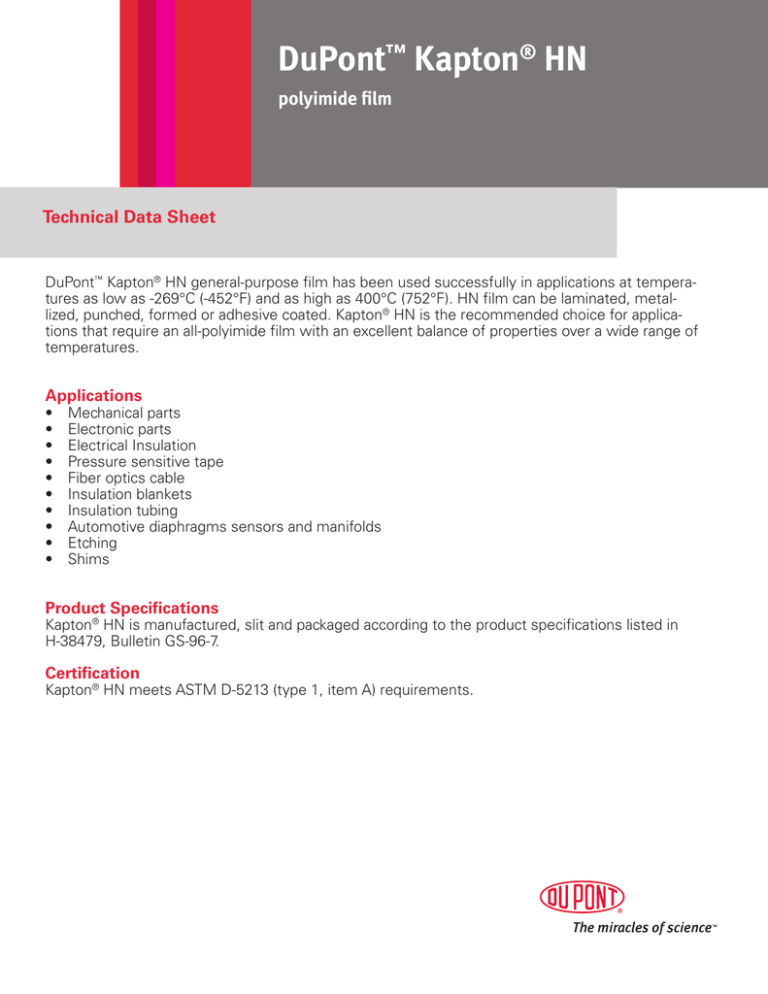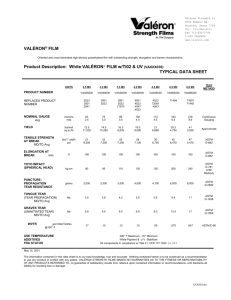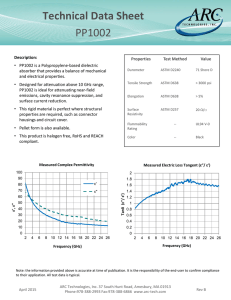
DuPont™ Kapton® HN
polyimide film
Technical Data Sheet
DuPont™ Kapton® HN general-purpose film has been used successfully in applications at temperatures as low as -269°C (-452°F) and as high as 400°C (752°F). HN film can be laminated, metallized, punched, formed or adhesive coated. Kapton® HN is the recommended choice for applications that require an all-polyimide film with an excellent balance of properties over a wide range of
temperatures.
Applications
•
•
•
•
•
•
•
•
•
•
Mechanical parts
Electronic parts
Electrical Insulation
Pressure sensitive tape
Fiber optics cable
Insulation blankets
Insulation tubing
Automotive diaphragms sensors and manifolds
Etching
Shims
Product Specifications
Kapton® HN is manufactured, slit and packaged according to the product specifications listed in
H-38479, Bulletin GS-96-7.
Certification
Kapton® HN meets ASTM D-5213 (type 1, item A) requirements.
Table 1
Physical Properties of DuPont™ Kapton® HN at 23°C (73°F)
Property
Ultimate Tensile Strength
at 23°C, (73°F)
at 200°C (392°F)
Ultimate Elongation
at 23°C, (73°F)
at 200°C (392°F)
Tensile Modulus
at 23°C, (73°F)
at 200°C (392°F)
Density
MIT Folding
Endurance
Unit
1 mil
25μm
2 mil
50μm
3 mil
75μm
5 mil
125μm
Test Method
psi (MPa)
33,500(231)
20,000(139)
33,500(231)
20,000(139)
33,500(231)
20,000(139)
33,500(231)
20,000(139)
ASTM D-882-91, Method A*
%
72
83
82
83
82
83
82
83
ASTM D-882-91, Method A
psi (GPa)
370,000 (2.5)
290,000 (2.0)
370,000 (2.5)
290,000 (2.0)
370,000 (2.5)
290,000 (2.0)
370,000 (2.5)
290,000 (2.0)
ASTM D-882-91, Method A
g/cc
1.42
1.42
1.42
1.42
ASTM D-1505-90
cycles
285,000
55,000
6,000
5,000
ASTM D-2176-89
0.07
(0.02)
0.21
(0.02)
0.38
(0.02)
0.58
(0.02)
ASTM D-1922-89
7.2
(1.6)
16.3
(1.6)
26.3
(1.6)
46.9
(1.6)
ASTM D-1004-90
Tear Strength-propagating
(Elmendorf), N (lbf)
Tear Strength, Initial
(Graves), N (lbf)
Yield Point at 3%
at 23°C, (73°F)
at 200°C (392°F)
MPa (psi)
69 (10,000)
41 (6,000)
69 (10,000)
41 (6,000)
69 (10,000)
41 (6,000)
69 (10,000)
41 (6,000)
ASTM D-882-91
Stress to produce 5% elong.
at 23°C, (73°F)
at 200°C (392°F)
MPa (psi)
90 (13,000)
61 (9,000)
90 (13,000)
61 (9,000)
90 (13,000)
61 (9,000)
90 (13,000)
61 (9,000)
ASTM D-882-92
Impact Strength
at 23°C, (73°F)
N•cm•(ft
lb)
78 (0.58)
78 (0.58)
78 (0.58)
78 (0.58)
DuPont Pneumatic Impact
Test
Coefficient of Friction, kinetic
(film-to-film)
0.48
0.48
0.48
0.48
ASTM D-1894-90
Coefficient of Friction, static
(film-to-film)
0.63
0.63
0.63
0.63
ASTM D-1894-90
Refractive Index
(sodium D line)
1.70
1.70
1.70
1.70
ASTM D-542-90
Poisson’s Ratio
0.34
0.34
0.34
0.34
Avg. three samples, elongated at 5, 7, 10%
Low temperature flex life
pass
pass
pass
pass
IPC-TM-650,
Method 2.6.18
*Specimen size 25 x 150 mm (1.6 in); jaw separation 100 mm (4 in), jaw speed, 50mm/min (2 in/min). Ultimate refers to the tensile strength and elongation measured at
break.
Table 2
Thermal Properties of DuPont™ Kapton® HN Film
Thermal Property
Typical Value
Test Condition
Test Method
None
None
ASTM E-794-85 (1989)
20 ppm/°C
(11 ppm/°F)
-14 to 38°C
(7 to 100°F)
ASTM D-696-91
0.12
296K
ASTM F-433-77 (1987)
2.87 x 104
23°C
Melting Point
Thermal Coefficient of Linear Expansion
Coefficient of Thermal Conductivity,
W/m•K
cal
cm•sec•°C
Specific Heat, J/g•K (cal/g•°C)
Heat Sealability
1.09 (0.261)
Differential calorimetry
not heat sealable
Solder Float
pass
Smoke Generation
Dm=<1
Shrinkage, %
30 min at 150°C
120 min at 400°C
NBS
smoke chamber
NFPA-258
IPC-TM-650
Method 2.2.4A;
ASTM D-5214-91
0.17
1.25
Limiting Oxygen Index, %
Glass Transition Temperature (Tg)
IPC-TM-650
Method 2.4.13A
37–45
ASTM D-2863-87
A second order transition occurs in Kapton between 360°C (680°F) and 410°C (770°F)
and is assumed to be the glass transition temperature. Different measurement techniques
produce different results within the above temperature range.
®
Table 3
Typical Electrical Properties of DuPont™ Kapton® HN Film at 23°C (73°F), 50% RH
Property Film Gage
Dielectric Strength
25 μm (1 mil)
50 μm (2 mil)
75 μm (3 mil)
125 μm (5 mil)
Typical Value
V/m kV/mm
303
240
205
154
(V/mil)
(7700)
(6100)
(5200)
(3900)
Dielectric Constant
25 μm (1 mil)
50 μm (2 mil)
75 μm (3 mil)
125 μm (5 mil)
3.4
3.4
3.5
3.5
Dissipation Factor
25 μm (1 mil)
50 μm (2 mil)
75 μm (3 mil)
125 μm (5 mil)
0.0018
0.0020
0.0020
0.0026
Volume Resistivity
25 μm (1 mil)
50 μm (2 mil)
75 μm (3 mil)
125 μm (5 mil)
•cm
1.5 x 1017
1.5 x 1017
1.4 x 1017
1.0 x 1017
Test Condition
Test Method
60 Hz
1/4 in electrodes
500 V/sec rise
ASTM D-149-91
1 kHz
ASTM D-150-92
1 kHz
ASTM D-150-92
ASTM D-257-91
Dimensional Stability
The dimensional stability of DuPont™ Kapton® polyimide film depends on two factors–the normal
coefficient of thermal expansion and the residual stresses placed in the film during manufacture.
The latter causes Kapton® to shrink on its first exposure to elevated temperatures as indicated in
the bar graph in Figure 1. Once the film has been exposed, the normal values of the thermal
coefficient of linear expansion as shown in Table 4 can be expected.
Figure 1. Residual Shrinkage vs. Exposure Temperature and Thickness, DuPont™ Kapton® HN and VN Films
Table 4
Thermal Coefficient of Expansion,
DuPont™ Kapton® HN Film, 25 μm (1 mil),
Thermally Exposed
Temperature Range, °C, (°F)
ppm/°C
30–100 (86–212)
17
100–200 (212–392)
32
200–300 (392–572)
40
300–400 (572–752)
44
30–400 (86–752)
34
For more information on DuPont™ Kapton® or other polyimide films, please contact your local representative, or visit
our website for additional regional contacts:
Americas
DuPont High Performance Films
U.S. Rt. 23 & DuPont Road
Circleville, OH 43113
Tel: 800-967-5607
Europe
DuPont de Nemours (Luxembourg)
S.A.R.L.
Rue General Patton
L-2984 Luxembourg
Tel: 352-3666-5935
Asia
DuPont Taiwan
No. 45, Hsing-Pont Road
Taoyuan, Taiwan, R.O.C.
Tel: 888 3 377 3688
Japan
DuPont-Toray Co., Ltd.
5-6 Nihonbashi Honcho 1-chome
Chuo-ku, Tokyo 103-0023 Japan
Tel: 81-3-3245-5061
kapton.dupont.com
©2011 DuPont. All rights reserved. The DuPont Oval Logo, DuPont™, The miracles of science™ , and Kapton® are registered trademarks or trademarks of
E.I. du Pont de Nemours and Company or its affiliates.
This information corresponds to our current knowledge on the subject. It is offered solely to provide possible suggestions for your own experimentations. It is not
intended, however, to substitute for any testing you may need to conduct to determine for yourself the suitability of our products for your particular purposes. This
information may be subject to revision as new knowledge and experience becomes available. Since we cannot anticipate all variations in actual end-use conditions,
DuPont makes no warranties and assumes no liability in connection with any use of this information. Nothing in this publication is to be considered as a license to
operate under or a recommendation to infringe any patent right.
Caution: Do not use in medical applications involving permanent implantation in the human body. For other medical applications, see “DuPont Medical Caution
Statement:, H-51459 or H-50102-2.
K-15345-1 04/11



